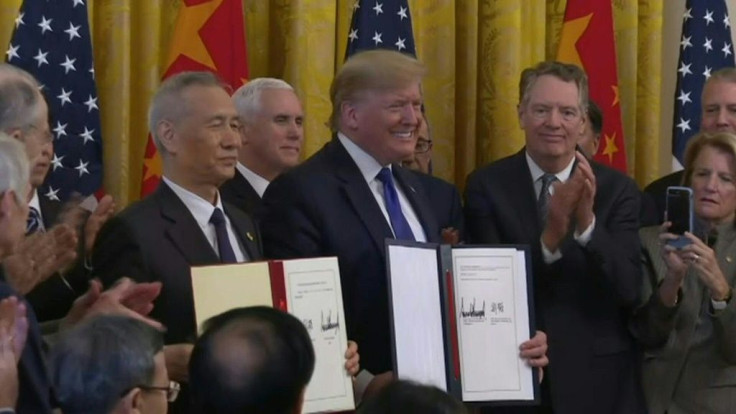US - China Trade War: Will EU To Sue If Trade Deal Violates WTO Rules?

KEY POINTS
- The EU is examining the US-China trade deal to determine whether it violates EU rules
- The EU is concerned because the deal dictates what China should buy from the U.S.
- The EU also is trying to convince Washington to scale back protectionist moves
The European Union’s trade commission said Thursday the alliance is closely examining the U.S.-China trade deal to determine whether it violates World Trade Organization rules.
EU Trade Commissioner Paul Hogan, who is in Washington to try to head off Trump administration threats to impose tariffs on a wide array of European goods, said the EU will file suit if it finds the agreement is out of compliance.
The phase one trade deal signed Wednesday calls on China to buy at least $200 billion in U.S. goods over the next two years.
"We haven't analyzed the document in detail, but we will. And if there's a WTO complaints issue, we will of course take a case," Hogan said, adding the European Commission is not “trigger happy” but will “stand up for our own economic interests.”
Trump currently is considering tariffs on $2.4 billion in French products in retaliation for a new tax on digital services affecting large U.S. tech firms and higher tariffs on German cars. A 25% tariff already has been imposed on most European wine in retaliation for government subsidies to Airbus, as well as levies on steel and aluminum.
Hogan said the U.S.-China deal presents a “managed trade outcome” rather than free trade as required by the WTO.
Hogan arrived in Washington Monday for three days of meetings to convince Trump administration officials to work more closely with the EU and WTO, and to scale back protectionism.
President Trump said Thursday farmers are happy with the China trade deal, which he called “one of the greatest trade deals ever made” and credited his imposition of tariffs with bringing Beijing to the table.
https://twitter.com/realDonaldTrump/status/1217827468230434818
https://twitter.com/realDonaldTrump/status/1217804029599920128
China currently is the U.S.’s largest trading partner, the U.S. Trade Representative’s Office said. For the first 11 months of 2019, the U.S. imported $418.58 billion in Chinese goods and exported $97.75 billion. Trump long has railed against the trade deficit with China and his goal in working out a new trade deal was to narrow the gap.
Questions, however, have arisen over whether the targets in the deal are realistic based on recent history.
Chad Brown, Reginald Jones senior fellow at the Peterson Institute for International Economics, called the targets “unrealistically large.” The products covered in the deal made up just $79 billion of U.S. exports to China in 2017.
https://twitter.com/ChadBown/status/1217579021036326913?s=20
Beacon Economics international trade adviser Jock O’Connell noted $10 billion of the $130 billion in merchandise exports to China in 2017 were goods not produced in the United States and it was unclear whether the new agreement is restricted to U.S.-made goods.
https://twitter.com/jockoconnell/status/1217594924633210880?s=20
Trade tensions between the U.S. and China are expected to continue simmering this year as tariffs largely remain in place and negotiations over the second phase of the agreement likely will be thornier.
"Are we in an ideal spot? No," top U.S. trade negotiator Robert Lighthizer told reporters before Wednesday’s signing. "Is this a massively good first step? Yes."
© Copyright IBTimes 2025. All rights reserved.






















